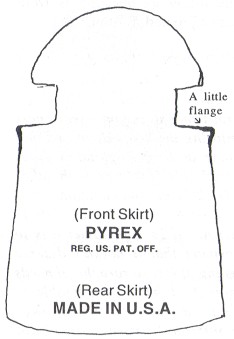Ask Woody
by N. R. Woodward
Reprinted from "Crown Jewels of the Wire", June 1994, page 15
N. R. "Woody" Woodward is the author of THE GLASS INSULATOR IN
AMERICA, 1988 Report and developed
the Consolidated Design Numbers identification system for glass insulators.
The following question comes from Burris Workman, Richmond, VA
QUESTION: I picked up a Pyrex CD 111 or CD 128 at a flea market for one
dollar. It looks like the CD 111 in McDougald's book, except it has a little
flange on the shoulders instead of rounded. It is 1/4" shorter than a CD
128. Also the inside threads come down to the base like a CD 111. The rear skirt
embossing is different than either listed for a CD 111 or a CD 128.

During the early years of production of carrier insulators at Corning, there
were several slight variations in style for the CD #128, as well as different
lettering arrangements. Although I believe I have record of most of these, I
don't have one that is identical to yours.
There are two possibilities. It could
be one of a production run that has not yet surfaced. But I think more likely
you have one of the early B series. Your drawing seems to fit exactly. If that
is the case, it should have two small letters (B and another) directly above the
"IN" in MADE IN U.S.A. Often these are difficult or impossible to
read. The words PAT. APPD. FOR should appear directly below the MADE IN U.S.A.
If they are not there, it would mean either that they did not come through on
that piece due to cooling too rapidly during pressing; or that they were left off that mold in error. Parts
of the intended engraving were sometimes omitted in haste to get the press
going. This is an error and would be later corrected in the mold. Without seeing
the item these are just opinions. If there are letters (two or three) in another
mold location, they would help.
The following question is from Larry Larned, Bolton, CT
QUESTION: While doing flood duty near Algona, Iowa last fall, I came across a
CD 129 Armstrong sitting on a fence post enjoying the sun. Upon arriving home in
New England, I compared this insulator with other CD 129's in my collection. It
is marked Armstrong's TS Made in U.S.A. @12 53. Either it is so common that it
doesn't deserve listing or it is so rare that it needs listing! I have been
unable to find a CD 129 marked Armstrong's in any insulator publication
including the McDougald's book Volume 1, p. 139. The word "Armstrong's" is
embossed in a semi-cursive italics. The glass is clear and very shiny. In the
sunlight it practically glows which is how I spotted it driving by at 65 mph.
Any information on this would be helpful. Also, what does TS refer to other than
the obvious?
You have located a sample from the first mold set for CD #129. The
set is dated 1953 but I have never run across any production earlier than the
1954 sample which you have. The highest mold number I have is 17. It may well
have been only a 20-mold set. The next year, 1955, production was begun with the
new-style lettering, the circle around the A in Armstrong, and not italicized.
I
imagine that samples from the 1953 mold set are quite scarce at this time.
The letters TS stand for Transposition insulator for use on a Steel pin;
as TW (CD
#203) is for Transposition insulator for use on a Wood pin.
| 